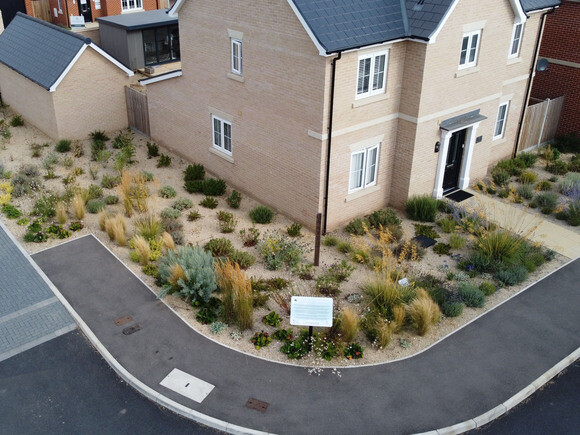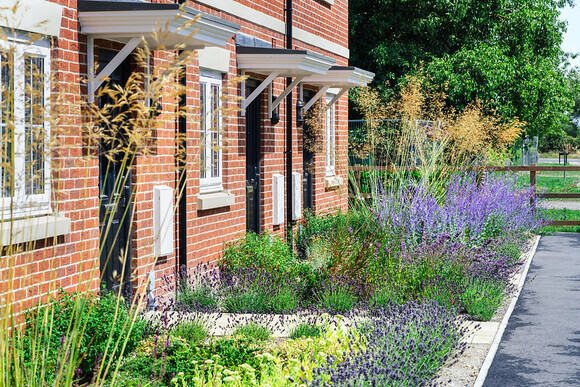Find out what the propagation and garden teams have been up to this week.

Planting at Chattowood Housing Development

Our neighbours, Lanswood Park, a commercial development adjacent to the gardens, gained planning permission for a residential development of eighty 3-5 bedroom houses. Subsequently, they approached us to ask if they could name their new development in honour of Beth and Andrew Chatto. Julia, Beth’s granddaughter and chair of the Gardens agreed, but in return asked if the Beth Chatto team could be involved in the design and planting of the site.
This presented an ideal opportunity to move away from the usual limited range of tried and tested evergreen shrubs and areas of mown grass that can be seen on every new build around the country. These plantings lack in any consideration to the potential of such areas in increasing the biodiversity of the wildlife and the aesthetics and engagement for future residents.


July 2023
The open, sunny site at Chattowood lends itself to drought-resistant planting which is based on the world- famous Gravel Garden around the corner at Beth Chatto’s Garden. The Gravel Garden has never been watered since its inception over thirty years ago and has inspired a generation of gardeners by proving to be sustainable and aesthetically pleasing with zero water use.
By choosing plants that are adapted and proven to withstand periods of low rainfall and planting them in a nutrient poor, yet free draining medium, this new area of planting greatly enhances the site and provides a different way of thinking about urban planting.


August 2023-filling out nicely
Rather than use a nutrient-rich topsoil, which invariably contains weed seeds and encourages weed growth, which results in the subsequent use of membrane and bark chippings to control the weeds, the plants at Chattowood are grown in approximately 30cm (12 inches) of locally sourced sand and gravel. This weed free planting aggregate will naturally dry out and form a crust on the surface making it difficult for weeds to establish. Deeper down the mixture retains moisture. The plants have been chosen to thrive in these conditions and, although initial growth will be much less than if plants were planted in a rich soil, they will establish without the need for any artificial feeding or constant watering and weeding.
As well as their drought resistant capabilities, plant choice was based on the following criteria:
- low maintenance, e.g, no prolific self seeders
- evergreens and evergreys for year round interest
- diverse range of height, texture and form
- insect friendly plants to attract a diverse range of pollinators, butterflies, moths etc, which in turn attract wildlife further up the food chain.
The initial phase of planting took place in April 2022, with the plants being thoroughly watered in immediately after planting. In most “average” summers this would have been the one and only watering these plants would receive. Little did we know that just weeks later we would be experiencing a severe dry spell and record high temperatures. Just 14mm of rain in ten weeks and constant temperatures of 30° celsius or more meant that plants were watered more than planned. The maintenance team at Chattowood, somewhat sceptical at first, have seen their efforts rewarded with remarkably few losses as the plants pulled through and started to grow away, attracting a diverse range of wildlife from the fascinating hummingbird hawkmoths, darting between the flowers of lavender and catmint, to the rather less welcome bunny rabbits trying out some new culinary delights, lamb’s ear being a particular favourite.

July 2022

July 2023
An important part of the planting design is engagement with those for whom the area will be part of their daily lives. We will continue to advise and support the community and maintenance team in the ongoing management of the planting.

Plants have also been chosen with bees, butterflies, and insects in mind increasing the natural diversity of the area considerably. The sand and gravel mix will also provide a home for several species of solitary bee which burrow and nest in such habitats.
Our wildlife expert, Dr Chris Gibson has visited the site on seperate occasions to carry out an insect survey on the Chattowood planting. Here are his findings so far.

*the adjacent development planting consists of turf, lollipop trees, a few low shrubs and bedding.
Chris says:
'20x more insects, all potential pollinators, were found in the Beth-style planted areas compared with 'standard' front gardens nearby, and this pattern has been found irrespective of weather conditions or insect abundance over the three summers. Whether drought or deluge and the number of plant casualties has been very small indeed. Furthermore, those few insects that were next door were almost exclusively using the flowering ‘weeds’ daring to break their way through the dying turf, or plants such as lavender that have been planted by the owners.'
The signs of biodiversity increase are promising and we will keep you updated on the developing planting and any future insect surveys.

You can find our full plant list HERE
Watch our video HERE


Perhaps it is obvious (but not to me) but what sort of sand would one use, please? We have completed a build and have a bag of sand and a bag of ballast - could we make use of any of these materials do you think?